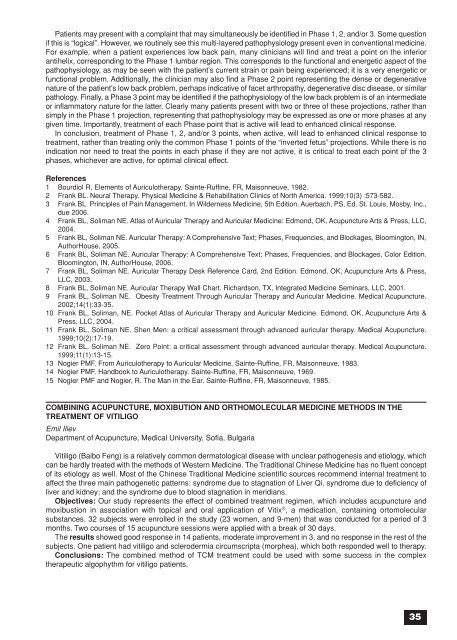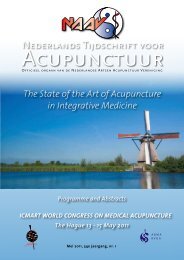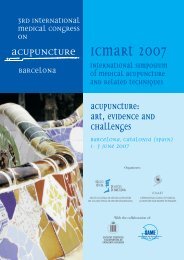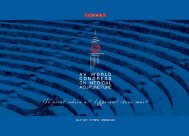Congress Abstracts full PDF - International Council of Medical ...
Congress Abstracts full PDF - International Council of Medical ...
Congress Abstracts full PDF - International Council of Medical ...
Create successful ePaper yourself
Turn your PDF publications into a flip-book with our unique Google optimized e-Paper software.
Patients may present with a complaint that may simultaneously be identified in Phase 1, 2, and/or 3. Some question<br />
if this is “logical”. However, we routinely see this multi-layered pathophysiology present even in conventional medicine.<br />
For example, when a patient experiences low back pain, many clinicians will find and treat a point on the inferior<br />
antihelix, corresponding to the Phase 1 lumbar region. This corresponds to the functional and energetic aspect <strong>of</strong> the<br />
pathophysiology, as may be seen with the patient’s current strain or pain being experienced; it is a very energetic or<br />
functional problem. Additionally, the clinician may also find a Phase 2 point representing the dense or degenerative<br />
nature <strong>of</strong> the patient’s low back problem, perhaps indicative <strong>of</strong> facet arthropathy, degenerative disc disease, or similar<br />
pathology. Finally, a Phase 3 point may be identified if the pathophysiology <strong>of</strong> the low back problem is <strong>of</strong> an intermediate<br />
or inflammatory nature for the latter. Clearly many patients present with two or three <strong>of</strong> these projections, rather than<br />
simply in the Phase 1 projection, representing that pathophysiology may be expressed as one or more phases at any<br />
given time. Importantly, treatment <strong>of</strong> each Phase point that is active will lead to enhanced clinical response.<br />
In conclusion, treatment <strong>of</strong> Phase 1, 2, and/or 3 points, when active, will lead to enhanced clinical response to<br />
treatment, rather than treating only the common Phase 1 points <strong>of</strong> the “inverted fetus” projections. While there is no<br />
indication nor need to treat the points in each phase if they are not active, it is critical to treat each point <strong>of</strong> the 3<br />
phases, whichever are active, for optimal clinical effect.<br />
References<br />
1 Bourdiol R. Elements <strong>of</strong> Auriculotherapy. Sainte-Ruffine, FR, Maisonneuve, 1982.<br />
2 Frank BL. Neural Therapy. Physical Medicine & Rehabilitation Clinics <strong>of</strong> North America. 1999;10(3) :573-582.<br />
3 Frank BL. Principles <strong>of</strong> Pain Management. In Wilderness Medicine, 5th Edition. Auerbach, PS, Ed. St. Louis, Mosby, Inc.,<br />
due 2006.<br />
4 Frank BL, Soliman NE. Atlas <strong>of</strong> Auricular Therapy and Auricular Medicine: Edmond, OK, Acupuncture Arts & Press, LLC,<br />
2004.<br />
5 Frank BL, Soliman NE. Auricular Therapy: A Comprehensive Text; Phases, Frequencies, and Blockages, Bloomington, IN,<br />
AuthorHouse, 2005.<br />
6 Frank BL, Soliman NE. Auricular Therapy: A Comprehensive Text; Phases, Frequencies, and Blockages, Color Edition.<br />
Bloomington, IN, AuthorHouse, 2006.<br />
7 Frank BL, Soliman NE. Auricular Therapy Desk Reference Card, 2nd Edition. Edmond, OK, Acupuncture Arts & Press,<br />
LLC, 2003.<br />
8 Frank BL, Soliman NE. Auricular Therapy Wall Chart. Richardson, TX, Integrated Medicine Seminars, LLC, 2001.<br />
9 Frank BL, Soliman NE. Obesity Treatment Through Auricular Therapy and Auricular Medicine. <strong>Medical</strong> Acupuncture.<br />
2002;14(1):33-35.<br />
10 Frank BL, Soliman, NE. Pocket Atlas <strong>of</strong> Auricular Therapy and Auricular Medicine. Edmond, OK, Acupuncture Arts &<br />
Press, LLC, 2004.<br />
11 Frank BL, Soliman NE. Shen Men: a critical assessment through advanced auricular therapy. <strong>Medical</strong> Acupuncture.<br />
1999;10(2):17-19.<br />
12 Frank BL, Soliman NE. Zero Point: a critical assessment through advanced auricular therapy. <strong>Medical</strong> Acupuncture.<br />
1999;11(1):13-15.<br />
13 Nogier PMF. From Auriculotherapy to Auricular Medicine. Sainte-Ruffine, FR, Maisonneuve, 1983.<br />
14 Nogier PMF. Handbook to Auriculotherapy. Sainte-Ruffine, FR, Maisonneuve, 1969.<br />
15 Nogier PMF and Nogier, R. The Man in the Ear. Sainte-Ruffine, FR, Maisonneuve, 1985.<br />
COMBINING ACUPUNCTURE, MOXIBUTION AND ORTHOMOLECULAR MEDICINE METHODS IN THE<br />
TREATMENT OF VITILIGO<br />
Emil Iliev<br />
Department <strong>of</strong> Acupuncture, <strong>Medical</strong> University, S<strong>of</strong>ia, Bulgaria<br />
Vitiligo (Baibo Feng) is a relatively common dermatological disease with unclear pathogenesis and etiology, which<br />
can be hardly treated with the methods <strong>of</strong> Western Medicine. The Traditional Chinese Medicine has no fluent concept<br />
<strong>of</strong> its etiology as well. Most <strong>of</strong> the Chinese Traditional Medicine scientific sources recommend internal treatment to<br />
affect the three main pathogenetic patterns: syndrome due to stagnation <strong>of</strong> Liver Qi, syndrome due to deficiency <strong>of</strong><br />
liver and kidney; and the syndrome due to blood stagnation in meridians.<br />
Objectives: Our study represents the effect <strong>of</strong> combined treatment regimen, which includes acupuncture and<br />
moxibustion in association with topical and oral application <strong>of</strong> Vitix ® , a medication, containing ortomolecular<br />
substances. 32 subjects were enrolled in the study (23 women, and 9-men) that was conducted for a period <strong>of</strong> 3<br />
months. Two courses <strong>of</strong> 15 acupuncture sessions were applied with a break <strong>of</strong> 30 days.<br />
The results showed good response in 14 patients, moderate improvement in 3, and no response in the rest <strong>of</strong> the<br />
subjects. One patient had vitiligo and sclerodermia circumscripta (morphea), which both responded well to therapy.<br />
Conclusions: The combined method <strong>of</strong> TCM treatment could be used with some success in the complex<br />
therapeutic algophythm for vitiligo patients.<br />
35







